TABLE OF CONTENTS
In culinary school or a cooking course, learning how to Julienne is one of the most popular subjects to look forward to. Learning how to make Julienne cuts the right way is essential whether you're going to school to polish your knife skills or improve your culinary abilities. In this article, we'll go over the fundamentals of Julienne and the tools you'll need to perform this technique.
What is a Julienne?
The Julienne cut is a French knife method for slicing vegetables into tiny matchsticks and planks. In addition, cutting veggies on the diagonal and stacking and cutting them into long, thin strips is a speedier method of chopping vegetables. In the absence of a ruler, the best approach to determine the size of your hand is to look at it.
As a general rule, the top portion of a thumb or index finger is one inch long. From the tip to the first knuckle, this section is comprised. It's advisable to measure your finger to prevent this from happening. Tiny and precise julienne cuts are often employed with hard fruits or vegetables like apples and beetroot because of their small and accurate sizes.
This short incision ensures fast and consistent frying and marinating. By chopping veggies into little bits, they provide salads and other foods with a nice crunch and texture. Check your kitchen drawer for a cutting tool if you already own a food processor. When you begin cutting the vegetables, you'll have a stack of precisely sliced veggies.

How is Julienne Used in Cooking?
Using a julienne cutter, you may cut vegetables into uniform lengths, allowing them to marinade or cook evenly and quickly while remaining crisp. In addition to enhancing the flavour of dishes, julienned vegetables may be used in the kitchen. Consider how crunchier salads, sides, and rainbow vegetable stir-fries would be if you used julienned carrots instead of grated carrots.
The julienne cut is ideal for cooking vegetables because it allows them to cook rapidly and uniformly while also integrating well with other meal ingredients, such as sauce. The julienne strips of a vegetable may be used as a salad garnish or as part of a whole dish, such as salade chinoise if the chef so desires.
What is the Right Size and Dimensions of Julienned Vegetables?
The length and thickness of the matchsticks vary on the kind of vegetable. Depending on the variety, they should be 2 inches long and 1/16 inch thick. The distance between the tip of your thumb and the top knuckle of your thumb may determine how long an inch is if you don't have a ruler.
Vegetable slices that are approximately 1/16th of an inch square and about 2 inches long may be made using the Julienne method. Peeling and washing the vegetable are prerequisites for this step. Next, you'll need to top and tail it before cutting it into a rectangle or square. Repeat cutting it into 1.5 mm (1/16th inch) thick slices once you've finished cutting it out. Pieces stacked on top of each other may be used to create 1.5 mm (1/16th inch) wide sticks.
The measures above are often called a "fine julienne" by chefs. In the culinary world, this sort of cut has been referred to as "a typical julienne," which is about the same size as "fine." A more typical measurement is 3 millimetres by 3 millimetres, more often referred to as an "allumette." When it comes to the ideal serving size for various dishes, chefs and teachers will have their preferences.

Tools You Need to Julienne
1.A kitchen cutting knife/Julienne peeler
To cut vegetables into juliennes, you'll need a sharp knife, just as you would for any other form of a cut in the kitchen. All home chefs should be familiar with basic knife skills. Food processors, julienne peelers, and mandolines may provide the same results as a knife. A julienne cutter is an excellent option if you don't plan on chopping a lot of food. Most of the time, there will be a julienne cutter on the kitchen counter.
2.Utility Knife/Chef's knife
To cut items into little bits, you need always use the proper knife. It depends on what you're doing with these knives: chef, utility, or santoku. The chef's knife is the most popular, with a blade length ranging from 8 to 10 inches. Almost any meal can be rapidly sliced through with it. In other words, it has been sharpened on both sides of its slightly curved cutting edge. Because of its versatility, it may be used for various uses. Use it for other chores, which makes this an easy decision.
Chefs use santoku knives, which resemble paring knives in appearance. It is a Japanese product. Japanese knives have a single, 12- to 15-degree bevel on the cutting edge and are often straight. A double angle is also common among western knife makers, allowing for more precise cutting. Using a smaller and lighter knife than a regular knife is excellent for chopping food for an extended period.
Despite its small size, this knife can be used for various tasks. It features a blade that ranges in length from four to seven inches. In terms of blade length, it is smaller than a chef's knife but more significant than a paring knife. A utility knife is ideal for cutting gala apples, radishes, or turnips since it is tiny enough. A longer knife would be inconvenient, such as a chef's or santoku. It's true, as you say.
3.A wood cutting board
Cutting on a cutting board is the only way to cut julienne. A hardwood cutting board is an ideal option since there are a lot of tiny cuts and pieces to produce. Small fruits and vegetables may generate quite a bit of food when they're chopped into thin strips. Wooden cutting boards can self-heal. Fibres reunited after cutting provide a smooth, durable surface that bacteria and mould have a hard time penetrating and growing on. The ideal cutting board for julienne and other knife cuts is made of wood as big as your kitchen space will allow.

How to Achieve Julienne Cuts With a Knife
A standard julienne or knife-only slicing method would be good to start if you want to present the basics. Carrots are often julienned because the technique softens and lightens the thick veggie.
You may begin in one of two ways: Of course, you are under no obligation to complete this step. It all comes down to the final product or food being created.
Remove the top portion of the carrot and the end of the tiny root. Trim the ends to a neat pair of symmetrical triangles. Cut the remainder of the carrot into 2 to 3-inch lengths. If you have any leftovers, you may use them in another dish or bulk up a salad for lunch.
To flatten one side of a carrot segment, cut a little bit off the length of the piece. It's easy to have a flat side like this. Afterwards, cut another small slice perpendicular to the previous one, and repeat the process for the second piece. Make a second, thinner cut. It's the same with the second thin slice. Repeat the same procedure on each side. Having a little bit of carrot in your hand indicates that the carrot has been correctly "squared-off" or "regularized." After that, make sure everything is centred.
Cut each rectangle into 1/16- or 1/8-inch-long strips to do this. The strips will be divided into more petite strips for the following stage, cutting them into smaller ones. Avoid making the planks uneven in any way possible.
After that, it's only a matter of stacking and chopping the veggies. Each piece of wood should be cut into boards of equal width. Stack the boards, one on top of the other. Matchstick-like carrots are the result of this method. Afterwards, you'll be able to brag about your accomplishment. Carrots julienned to perfection have served their purpose.

How to Achieve Julienne Cuts with a Peeler
When peeler blades are not being used, the plastic cover should be switched over to prevent them from becoming dirty. If you're looking for a specific item in your kitchen drawer, avoid accidentally touching a blade.
It might be helpful to hold the vegetables in place while you're making the slices using a julienne peeler on a cutting board. When you're holding small, spherical vegetables in your hand, your thumb, palm, and other fingers are at risk of being cut.
If you use a julienne peeler, probably, you won't be able to peel all of your vegetables at the same time as you would want. The peeler should be put aside when you cannot cut through the vegetable without getting stuck. Using a knife, finely slice the remaining vegetables to make a salad.
The julienne peeler only works with a limited number of veggies. Complex meals rule here since there aren't many tender ones in this dish.

How to Julienne an Onion
Here are 7 Steps to Julienne an Onion:
- Make sure to remove the top and bottom layers before peeling.
- Starting from one of its ends, cut the onion in half vertically.
- Using a sharp kitchen knife, cut the onion carefully in half lengthwise and place the cut side down on a work surface.
- You can chop vegetables into matchstick-sized pieces by angling your knife 45 degrees away from the cutting board.
- Each time you make a new cut, you'll notice that the angle of your knife changes.
- When you get to the center of the onion, your cutting board should be at a 90-degree angle.
- The onion will begin to tremble around halfway through. Keep slicing until the onion is completely gone.
Red onions are a stunning addition to any salad, so try them out next time you prepare one.
How to Julienne Carrots
Carrots may be sliced in two ways: using a julienne peeler or a knife. It's good to get a carrot peeler if you plan to chop up many carrots (or other veggies, like zucchini and cucumbers). Both inexpensive and practical, they are an excellent choice. Carrots are a breeze to chop up when you have one of these handy.
Julienne cut with a peeler
Place a giant carrot on a flat surface with the long side facing down. After that, cut it into strips using a peeler. Peel the carrot, starting at the thick end and working your way to the thin end. Very thin carrot matchsticks may be made by doing this. A thin carrot can no longer be chopped into strips by repeating the operation. That's all there is to it!
The ends of carrots may be left on if they have them, saving you time. Carrots may be secured with their support.
Julienne cut with a knife
Now, what if you don't have a peeler? Honestly, it's not that big of an issue. If desired, carrots may be sliced into thin strips using a knife. The more time you put in, the better your knife skills will wow your friends and family. Even so, you'll end up with precisely formed matchstick-shaped carrots. Here's how it's done, step by step:
First, remove the carrots' outer layer. A dish of halved strawberries is then ready. Use a vegetable peeler to remove the carrot peels, and then discard them.
Finally, turn the carrots over so the long side faces up on a chopping board. After that, chop the carrots finely. All of the carrots' tops should be removed. Then, using a sharp chef's knife, cut each one into two or three pieces. Move the carrots to a more accessible location. The length of each should be between 2 and 3 inches.
Depending on the size of your carrots, you'll need to adjust the quantity and size of the carrots you use. Cut each piece lengthwise into thin boards.
It may be sliced into matchstick-thin matchsticks with a keen knife. Continue the procedure with the remaining planks. If you want to speed things up, you may stack the planks and cut them one at a time.

How to Julienne Soft or Irregular-Shaped Items
It is possible to julienne tomatoes, even if this is not regularly done. Tomatoes that have been halved should be your starting point. Using a baking sheet, place one-half skin-side down on the other. Make a slit between the tomato's seed and its flesh with a chef's knife. Use a single motion with your knife to keep cutting through the seed's flesh. Place the tomato skin-side down on a chopping board before slicing into strips. The seeds from the tomato might be used for something else. Salads without tomato seeds benefit significantly from this technique.
Conclusion
Food cooks faster and more evenly when using basic kitchen cuts. It's also a bonus that the plate's uniformity enhances the aesthetic of any meal served on it. It may seem complicated, but the delicate cut may be completed in a few simple stages with a bit of care.
You may also julienne in various ways, depending on the kind of food you're cutting and the available time. To become a matchstick expert, you can start with doing a Julienne with a knife first and experiment with other techniques after you've completely mastered the traditional way.






















Leave a comment
All comments are moderated before being published.
This site is protected by hCaptcha and the hCaptcha Privacy Policy and Terms of Service apply.